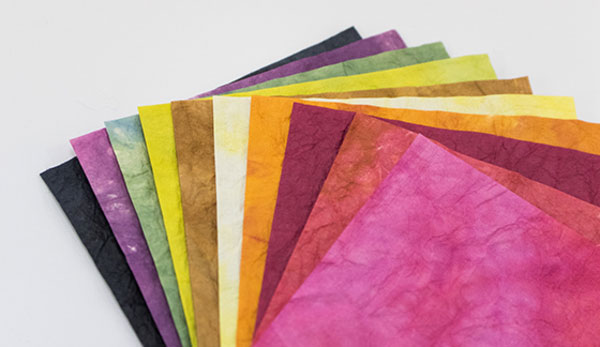
- Traditional Japanese paper
- Ehime
Ozu traditional Japanese paper Ozu washi
Thin and refined high-quality traditional paper
Excellent pieces handmade with time-honored techniques
Description
What is Ozu traditional Japanese paper ?
Ozu traditional Japanese paper (called Ozu washi in Japanese) is a handmade paper made in the town of Uchiko, Ehime prefecture. The history of papermaking of Ozu washi dates back to the Heian period (794-1185), and the current style of Ozu washi emerged in the mid-Edo period (1603-1868). Despite a declining workforce, it is still a successful and high-quality washi today.
Ozu washi features a variety of raw material such as paper mulberry, paperbush, gampi, hemp, bamboo, straw, and sunset hibiscus. It has many uses such as screen doors, kites, colored papers, and calligraphy, in particular. The fineness and evenness of Ozu washi has contributed to its reputation as high quality, user-friendly paper that is ideal for calligraphy. After being allowed to mature for three to four years, Ozu paper for calligraphy naturally develops an antique patina and a smoother surface, which allows for great brush strokes and unique artistic expressions.
History
The origin of Ozu washi is lost to time, but a document called Engishiki which gives detailed descriptions of regulations and was completed in the Heian period mentions Ozu washi so it is assumed that production began at some earlier point. A history book about papermaking entitled Kamisuki-choho-ki, states that a well-known poet, Hitomaro KAKINOMOTO, began papermaking in Iwami province (now Shimane prefecture) and the technique was introduced to Ehime. The current style of Ozu washi developed by around 1688–1704. New techniques were introduced by a craftsman named Zenjomon SHUSHO. As a result, papermaking became one of the key industries of the region and it was even regarded as the best washi in Japan. In 1910, a new paper mill was built employing up to four hundred and thirty people, but by the end of World War II only seventy-four workers remained.
In addition to the war, production has been largely affected by mechanization. However, despite hard times craftsmen have upheld the handwork techniques and Ozu washi has been preserved into modern times.
Production Process
- 1. Soaking and boiling
The basic raw materials of paper mulberry, paperbush, and gampi are softened by being soaked in water and then boiled with soda ash in a vat for a few days to remove impurities from the bark and make the fiber tissues easier to disentangle.
- 2. Removal of lye and bleaching
In order to remove impurities and any dust particles resulting from boiling, the fibers are thoroughly washed. After rinsing, the fibers are left to dry in the sun to dry and remove lye residue, after which the fibers are mixed with a water diluted bleaching solution. This ensures the finished paper will not turn brown over time.
- 3. Washing, beating
The fibers are removed and carefully washed to remove any bleach and chemicals, which would damage the paper if left alone. Dust and any debris is removed and the fibers are machine beaten to be separated and prepared for papermaking.
- 4. Papermaking
Beaten fibers are mixed with a gelatinous substance extracted from the roots of sunset hibiscus in a watertank. When well mixed, a scoop of the liquid paper is poured into a draining board and then set in a wooden frame. There are two major hand papermaking methods: nagashisuki (papermaking in flowing water) which is the current method used by this craft and tamesuki (papermaking using stored water).
With the former method, the liquid paper is scooping onto a draining board and gently shaken back and forth to give a uniform thickness. The artisan moves the board with their entire body, including their arms, legs, and waist. When the right thickness is achieved, the sheet is removed and the sheets are carefully stacked.
- 5. Pressing
The stacks are left overnight, slowly pressed to remove liquid, and great care is taken not to misshape or damage them. The length of time depends on the paper type as screen paper takes three hours of pressing and calligraphy paper takes twenty-four.
- 6. Drying
Next is the drying process. Techniques vary according to the production area. Some artisans lay papers on a board to sun dry while others place them in a drying room. Ozu washi craftsmen use a drying machine. Each paper is laid individually on a stainless steel plate and quickly smoothed out with a wide brush to ensure no wrinkling. By the time the artisan has reached the end of the plate, the first paper sheet is already dry, ready to be removed and stacked and a new sheet is stuck in its place.
- 7. Selecting and cutting
Each sheet is checked for quality, evenness, and correct dimensions. Any debris or dust is brushed off and the papers are cut to standard sizes. This is the final production process for this craft. There are some kinds of washi which have additional processes such as the spreading of a solution made from water, glue, and alum, but not for Ozu washi.
Facility Information
Ozu Washi hall
-
Address
-
Tel.+81-893-44-2002
-
ClosedAround the New Year
-
Business Hours9am to 5pm (Sat & Sun: 9am to 3pm)
Other Traditional Japanese paper
- Mino traditional Japanese paper
- Echizen traditional Japanese paper
- Tosa traditional Japanese paper
- Sekishu traditional Japanese paper
- Inshu traditional Japanese paper
- Awa traditional Japanese paper
- Ozu traditional Japanese paper
- Echu traditional Japanese paper
- Uchiyama Japanese paper

































































































































































































































































































